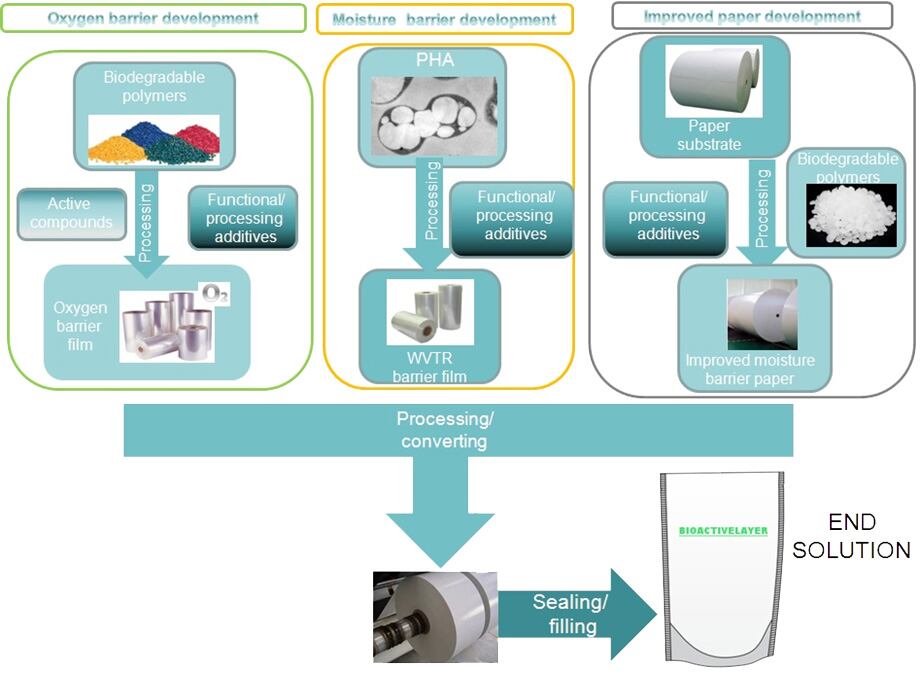Modified Atmosphere Packaging (MAP) is often used to preserve dried food, but the project says there is no cost-effective and proven technology capable of fully recycling multilayer plastic materials – resulting in packaging being sent to landfill.
To tackle the problem, BioActiveLayer is developing an alternative bio-based material, suitable for MAP, for the dried food industry.
“At the moment there are different laminated flexible packaging options which reach the required barrier properties: however, these structures are based on petroleum based materials (a non-renewable source), and are usually not biodegradable,” a spokesperson told FoodProductionDaily.com
“Our project will provide an active and renewable pouch with the required properties for packaged baby dry foods, and using modified atmosphere packaging technology. None of the currently available commercial solutions can alone cover all the requirements: being 100% biodegradable and incorporating an active compound to extend the current baby dry food shelf-life.”
Longer shelf life, easier transportation
BioActiveLayer is being driven by a growing global demand for dried foods, which offer cheaper transportation, longer storage life, and ease of use.
However, the project says dried foods (such as dried baby milk) are particularly susceptible to oxygen rancidity and residual oxygen levels should be below 0.2%.
Pouches and MAP are a popular packaging format: however, recycling methods do not always cater for these products.
“The EU food packaging industry alone uses approximately 247,000 tonnes per annum of thin aluminium foil," the spokesperson said. "In laminated structures, there is no adequate or proven technology capable of fully recycling these materials in an efficient and cost-effective manner. This results in more than 80% of current MAP packaging being sent to landfill.”
No cracks or wrinkles
The project is working on three areas. Biodegradable polymers will create an oxygen barrier film; PHA (Polyhydroxyalkanoates) will be processed into a moisture barrier; and improved barrier paper will be developed. These branches of research will come together to create a multilayer pouch.
The two year project will finish in August 2015. Improved barriers will contribute to a 24 month shelf life, alongside other benefits.
“We will improve polymer properties so that excellent product performance can be achieved after packaging forming. This means that any cracks or wrinkles, typical for today’s fiber based packages and aluminum foil, will not be source of problems in the pouch.”
The pouch will have a simplified production process, and will be compatible with existing lines, the project says.
What has been achieved in the first year?
The first year of research has focused on maximising performance and properties of each individual layer.
“A detailed development of the different materials forming each layer of the multilayer structure has been made. We have created specific coated materials to improve paper properties, and developed specific composite materials to obtain oxygen and moisture barrier structures.
“We have looked at each material separately to improve its properties and achieve the best performance of each layer.
“At the same time, we are carrying out food assessments and biodegradability studies. Now, we are selecting the best solutions which will be integrated into a multilayer structure – the final packaging.”
The technology developed by the BioActiveLayer project could be applied to other MAP foods besides dried products, such as meat or fish, although each food would be evaluated independently.
The BioActiveLayer consortium is supported by a €1.2m grant from the EU Seventh Framework programme. The partners are A. Hatzopoulos S.A. (Flexible Packaging), Nuevas Tecnicas de Coloracion SL (Chemical Compounding), Skymark Packaging International Limited (Packaging Films), Belourthe S.A. (Producer of Baby Food Cereals), Plusfresc (Spanish Supermarket Chain), Instituto Tecnologico del Embalaje, Transporte y Logistica, Wageningen University and the UK Materials Research Institute.

